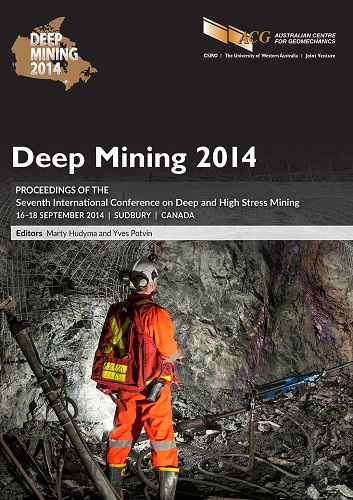Strainburst hazard awareness for development miners

|
Authors: Lyle, RR; Wrixon, SJ; Price Jones, A |
DOI https://doi.org/10.36487/ACG_rep/1410_44_Lyle
Cite As:
Lyle, RR, Wrixon, SJ & Price Jones, A 2014, 'Strainburst hazard awareness for development miners', in M Hudyma & Y Potvin (eds), Deep Mining 2014: Proceedings of the Seventh International Conference on Deep and High Stress Mining, Australian Centre for Geomechanics, Perth, pp. 629-639, https://doi.org/10.36487/ACG_rep/1410_44_Lyle
Abstract:
In the course of new mine construction or of expanding mine workings, the mine development crews are the first to encounter the realities of stress related strain behaviour of the rock. These hazards are encountered generally before the more comprehensive seismic monitoring and rockburst management systems, common in production areas, are in place. As such, strainbursting must be considered an important hazard facing mine personnel. The nature of such hazards, although broadly foreseeable, is that their occurrence is unpredictable. Using a risk-based approach, Cementation Canada has developed practical guidelines for strainburst hazard awareness for its development miners and shaft sinkers. The objectives are to raise awareness, to highlight observable indicators, and to minimise exposure and mitigate the negative impacts of strainbursting, with the ultimate goal of zero harm. This paper covers the background to this challenge, explains how it fits into the Internal Responsibility System (IRS), and provides details of how the programme is being implemented. It is desired to share this programme to improve safety in our industry and to gather feedback in order to continuously improve upon this initiative.
References:
Blake, W & Hedley, DGF 2003, Rockbursts: case studies from North American hard-rock mines, Society for Mining, Metallurgy and Exploration, Littleton.
Brady, BGH 1990, Rockbursts and Seismicity in Mines, A.A. Balkema, Rotterdam.
Cheung, DJ & Kazakidis, VN 2014, ‘Methodology for design risk assessment in burst-prone mines: A case study’, Canadian Institute of Mining, Metallurgy and Petroleum Journal, vol. 5, no. 2, pp. 107-118.
Deck, BK 1997, Management of Rockbursts – Statement of Policy and Health and Safety Guidelines, Ontario Ministry of Labour Health and Safety Guideline.
Kaiser, PK & Tannant, DD 1999, ‘Lessons learned for deep tunnelling from rockburst experiences in mining’, Proceedings Vorerkundung und Prognose der basistunnels am Gotthard und am Lötschberg, A.A. Balkema, Rotterdam, pp. 325-337.
Kaiser, PK, Tannant, DD & McCreath, DR 1996, Canadian rockburst support handbook, Geomechanics Research Centre, Laurentian University, Sudbury.
Potvin, Y, Hudyma, M & Jewell, RJ 2000, 'Rockburst and seismic activity in underground Australian mines-an introduction to a new research project', Proceedings of the International Conference on Geotechnical & Geological Engineering, Technomic Publishing, Lancaster, on CD- ROM.
Strahlendorf, P 2013, ‘The Internal Responsibility System’, Presentation given to the Workplace Safety North Mining Health and Safety Conference, Sudbury.
Wagner, H 1982, Rockbursts and Seismicity in Mines, South African Institute of Mining and Metallurgy, Johannesburg.
White, WS 1946, Rock bursts in the granite quarries at Barre, Vermont, United States Geological Survey Circular 13, US Department of the Interior, Geological Survey, Washington.
© Copyright 2025, Australian Centre for Geomechanics (ACG), The University of Western Australia. All rights reserved.
View copyright/legal information
Please direct any queries or error reports to repository-acg@uwa.edu.au
View copyright/legal information
Please direct any queries or error reports to repository-acg@uwa.edu.au